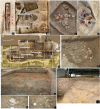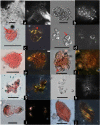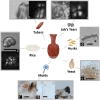Early evidence for beer drinking in a 9000-year-old platform mound in southern China
- PMID: 34383818
- PMCID: PMC8360526
- DOI: 10.1371/journal.pone.0255833
Early evidence for beer drinking in a 9000-year-old platform mound in southern China
Abstract
Alcoholic beverages played an essential role in rituals in ancient societies. Here we report the first evidence for beer drinking in the context of burial ritual in early Holocene southern China. Recent archaeological investigations at Qiaotou (9,000-8,700 cal. BP) have revealed a platform mound containing human burials and high concentrations of painted pottery, encircled by a human-made ditch. By applying microfossil (starch, phytolith, and fungi) residue analysis on the pottery vessels, we found that some of the pots held beer made of rice (Oryza sp.), Job's tears (Coix lacryma-jobi), and USOs. We also discovered the earliest evidence for using mold saccharification-fermentation starter in beer making, predating written records by 8,000 years. The beer at Qiaotou was likely served in rituals to commemorate the burial of the dead. Ritualized drinking probably played an integrative role in maintaining social relationships, paving the way for the rise of complex farming societies four millennia later.
Conflict of interest statement
No authors have competing interests.
Figures









Similar articles
-
Identification of 10,000-year-old rice beer at Shangshan in the Lower Yangzi River valley of China.Proc Natl Acad Sci U S A. 2024 Dec 17;121(51):e2412274121. doi: 10.1073/pnas.2412274121. Epub 2024 Dec 9. Proc Natl Acad Sci U S A. 2024. PMID: 39652763 Free PMC article.
-
Revealing a 5,000-y-old beer recipe in China.Proc Natl Acad Sci U S A. 2016 Jun 7;113(23):6444-8. doi: 10.1073/pnas.1601465113. Epub 2016 May 23. Proc Natl Acad Sci U S A. 2016. PMID: 27217567 Free PMC article.
-
The origins of specialized pottery and diverse alcohol fermentation techniques in Early Neolithic China.Proc Natl Acad Sci U S A. 2019 Jun 25;116(26):12767-12774. doi: 10.1073/pnas.1902668116. Epub 2019 Jun 3. Proc Natl Acad Sci U S A. 2019. PMID: 31160461 Free PMC article.
-
Introduction: Alcohol and Alcoholism.Clin Liver Dis. 2019 Feb;23(1):1-10. doi: 10.1016/j.cld.2018.09.009. Clin Liver Dis. 2019. PMID: 30454824 Review.
-
Bread, beer and wine: yeast domestication in the Saccharomyces sensu stricto complex.C R Biol. 2011 Mar;334(3):229-36. doi: 10.1016/j.crvi.2010.12.016. Epub 2011 Feb 1. C R Biol. 2011. PMID: 21377618 Review.
Cited by
-
Beer and Microbiota: Pathways for a Positive and Healthy Interaction.Nutrients. 2023 Feb 7;15(4):844. doi: 10.3390/nu15040844. Nutrients. 2023. PMID: 36839202 Free PMC article. Review.
-
Identification of 10,000-year-old rice beer at Shangshan in the Lower Yangzi River valley of China.Proc Natl Acad Sci U S A. 2024 Dec 17;121(51):e2412274121. doi: 10.1073/pnas.2412274121. Epub 2024 Dec 9. Proc Natl Acad Sci U S A. 2024. PMID: 39652763 Free PMC article.
-
Changes of Neolithic subsistence in south Hangzhou Bay coast, eastern China: An adaptive strategy to landscape processes.Front Plant Sci. 2022 Sep 20;13:1000583. doi: 10.3389/fpls.2022.1000583. eCollection 2022. Front Plant Sci. 2022. PMID: 36204055 Free PMC article.
-
Origin, Function, and Implications of Intestinal and Hepatic Macrophages in the Pathogenesis of Alcohol-Associated Liver Disease.Cells. 2025 Jan 30;14(3):207. doi: 10.3390/cells14030207. Cells. 2025. PMID: 39936998 Free PMC article. Review.
-
Beer-gut microbiome alliance: a discussion of beer-mediated immunomodulation via the gut microbiome.Front Nutr. 2023 Jul 25;10:1186927. doi: 10.3389/fnut.2023.1186927. eCollection 2023. Front Nutr. 2023. PMID: 37560062 Free PMC article. Review.
References
-
- Dietler M. Alcohol: Anthropological/Archaeological Perspectives. Annual Review of Anthropology. 2006;35(1):229–49.
-
- McGovern PE. Uncorking the Past: The Quest for Wine, Beer, and Other Alcoholic Beverages. Berkeley: University of California Press; 2009.
-
- Joffe AH. Alcohol and social complexity in ancient Western Asia. Current Anthropology. 1998; 39(3):297–322.
-
- Hayden B, Canuel N, Shanse J. What Was Brewing in the Natufian? An Archaeological Assessment of Brewing Technology in the Epipaleolithic. J Archaeol Method Theory. 2012;20(1):102–50.
-
- Dietrich O, Heun M, Notroff J, Schmidt K, Zarnkow M. The role of cult and feasting in the emergence of Neolithic communities. New evidence from Göbekli Tepe, south-eastern Turkey. Antiquity. 2012;86(333):674–95.
Publication types
MeSH terms
Substances
LinkOut - more resources
Full Text Sources
Medical

